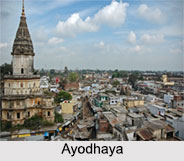 Ancient North Indian Cities depict the civilized city life, proper business centers, temples that portray the art and architecture of the different dynasties.
Ancient North Indian Cities depict the civilized city life, proper business centers, temples that portray the art and architecture of the different dynasties.
The history of ancient cities is of the ages or eras in the evolution of Indian history. The ancient civilization is also known in history as Indus-Sarasvati Civilization, the history of which can be traced back to the Bronze Age, beginning from 10,000 BC, which had disseminated and prospered in the north and north western part of India. Some of the ancient cities in Northern part of India are Ayodhya, Budaun, Chunar, Hansi, Kalibangan, Kannauj, Kurukshetra and many more.
Anantnag
Anantnag in Jammu and Kashmir, is an ancient city that came into existence as a market town around 5000 BC, making it one of the oldest urban human settlements in the world.
Kannauj
 Kannauj was one of the most beautiful ancient cities in India that was ruled by different rulers. The city was described as, "a city which raised its head to the skies and which in strength and beauty might boast of being unrivalled." Kannauj now falls under Kannauj district in Uttar Pradesh. Kannuaj remained a central point for the three powerful dynasties, namely the Gurjara Pratiharas, Pala Dynasty and Rashtrakuta Dynasty between the 8th and 10th centuries. For this resulted the "Tripartite Struggle" in the early India and the early medieval India.
Kannauj was one of the most beautiful ancient cities in India that was ruled by different rulers. The city was described as, "a city which raised its head to the skies and which in strength and beauty might boast of being unrivalled." Kannauj now falls under Kannauj district in Uttar Pradesh. Kannuaj remained a central point for the three powerful dynasties, namely the Gurjara Pratiharas, Pala Dynasty and Rashtrakuta Dynasty between the 8th and 10th centuries. For this resulted the "Tripartite Struggle" in the early India and the early medieval India.
Ayodhya
Ayodhya is known as the land of Lord Rama. It is believed that, Ayodhya is the birthplace of Lord Rama. Ayodhya has the rich history from the early era, but later lost importance when the rule of Delhi Sultanate began. Later, during the Mughal rule, Ayodhya lost its economic importance. But Ayodhya grew up with the Muslim culture along with Kanpur and Lucknow during the rule of Nawabs of Awadh. Ayodhya was annexed in 1856 by the Governor Generals of British East India Company.
Kurukshetra
The history of Kurukshetra began from the time of Puranas. It came in the limelight of history, when the battle of Kurukshtera happened for the dynastic succession struggle between two groups of cousins, the Kauravas and Pandavas, for the throne of Hastinapur.
Kalpi
Kalpi now in Jalaun district of Uttar Pradesh is known as the birthplace of sage Ved Vyasa, who had splendidly authored Mahabharata.
Chunar
Chunar is located in the Mirzapur District of Uttar Pradesh. It is the place where Chunar Fort is located. Chunar is well-known for the pottery work, especially clay toys.
Awantipur
Awantipora was named after Avanti Varman, who built many Hindu temples. It is now under Pulwama district of Jammu and Kashmir.



















